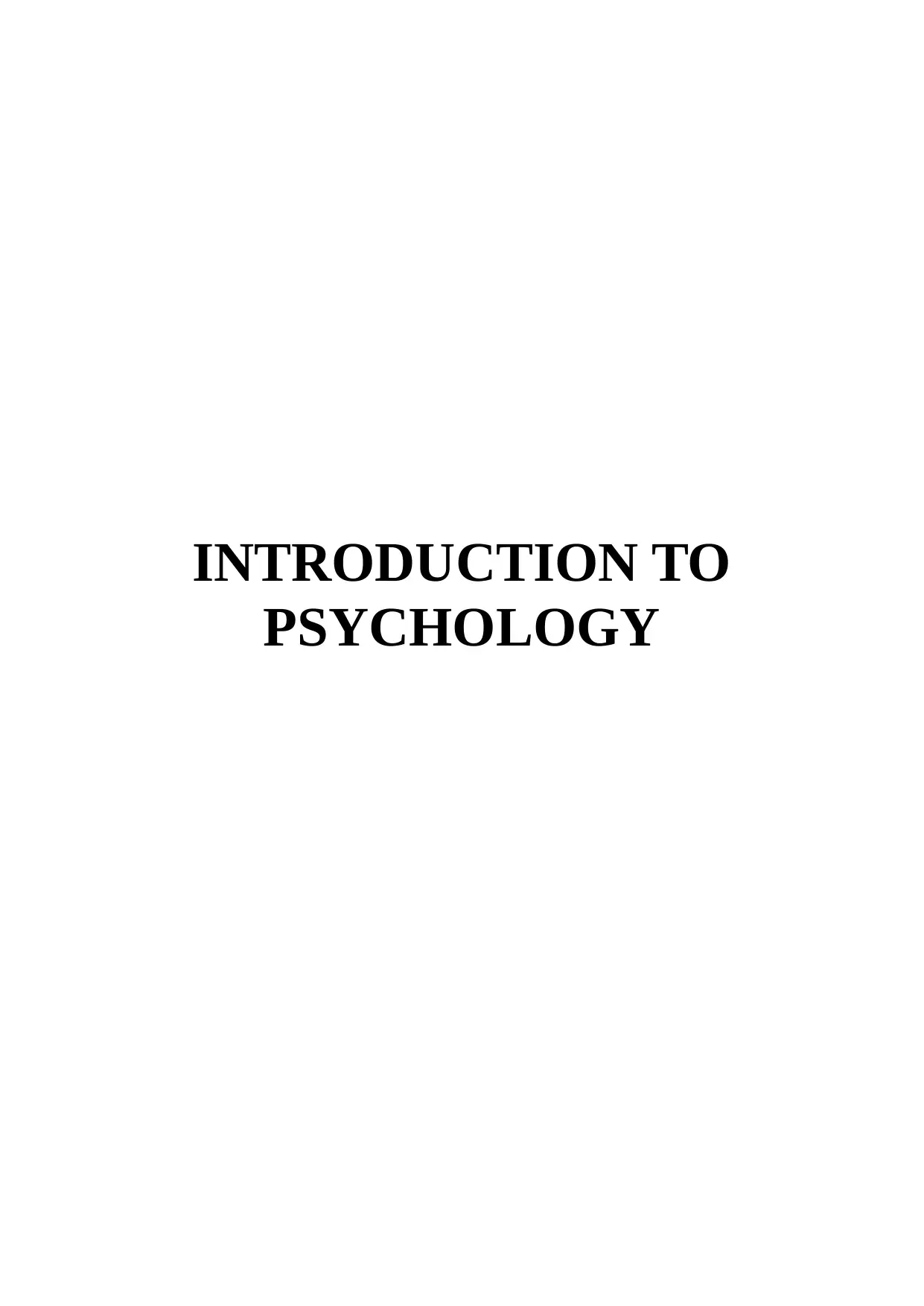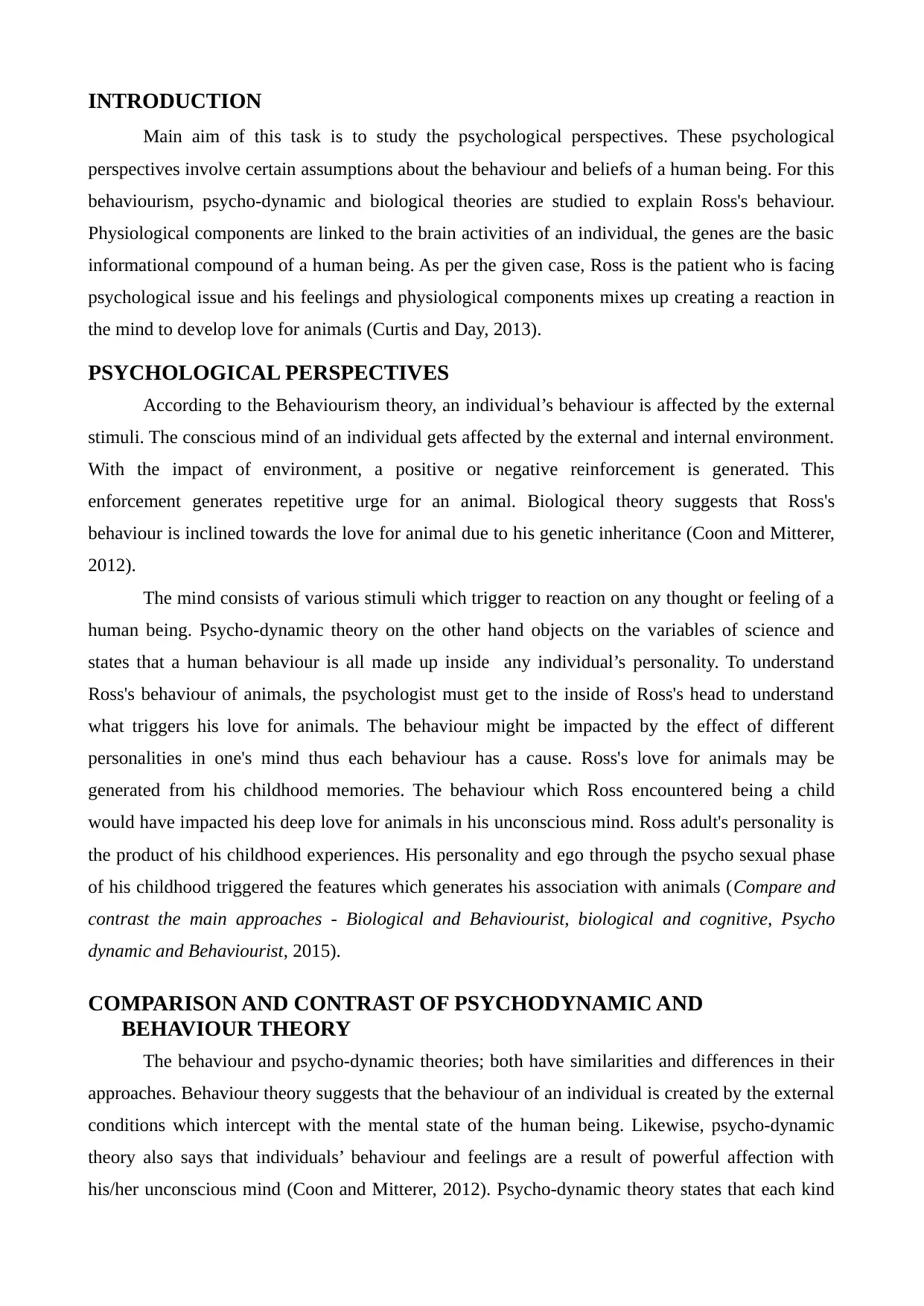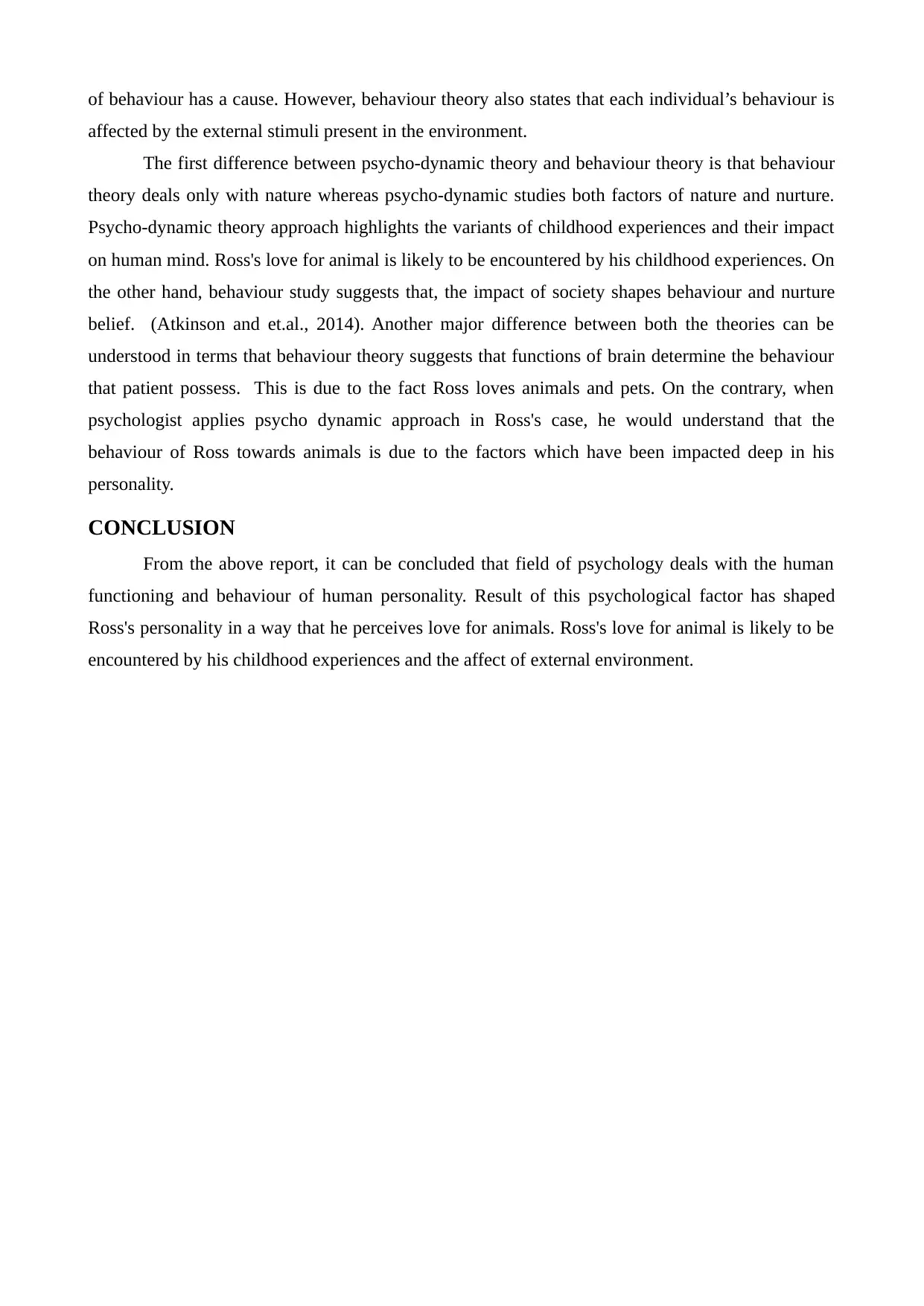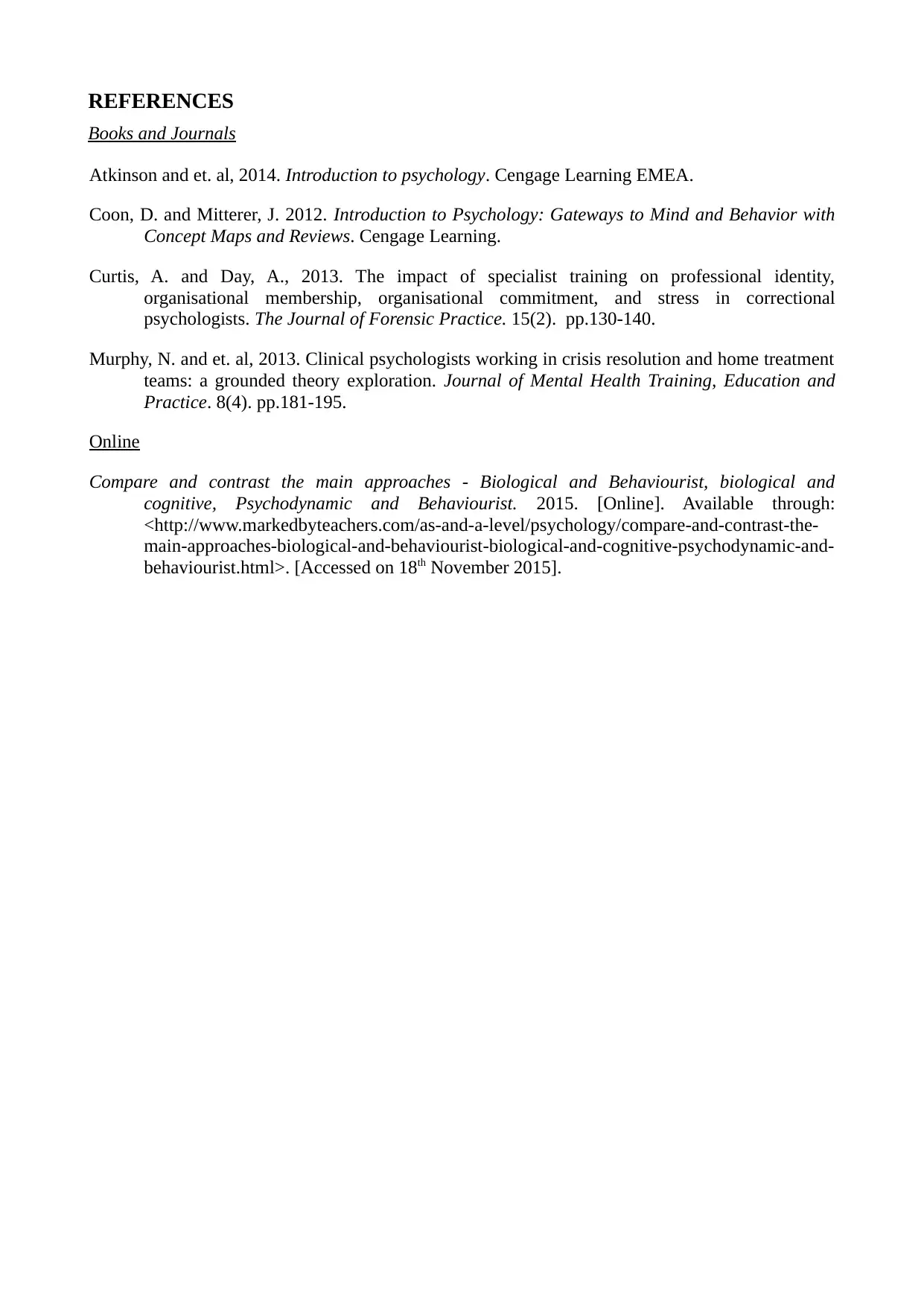Introduction to Psychology Essay
VerifiedAdded on 2019/12/03
|4
|915
|303
Essay
AI Summary
This essay examines Ross's love for animals through the lens of various psychological perspectives, including behaviorism, psychodynamic theory, and biological theory. It compares and contrasts the behaviorist and psychodynamic approaches, highlighting their similarities and differences in explaining behavior. The essay argues that Ross's behavior is likely shaped by a combination of childhood experiences (psychodynamic) and environmental factors (behaviorism), potentially influenced by genetic predispositions (biological). The conclusion emphasizes the multifaceted nature of human behavior and the importance of considering multiple perspectives for a comprehensive understanding.

INTRODUCTION TO
PSYCHOLOGY
PSYCHOLOGY
Paraphrase This Document
Need a fresh take? Get an instant paraphrase of this document with our AI Paraphraser

INTRODUCTION
Main aim of this task is to study the psychological perspectives. These psychological
perspectives involve certain assumptions about the behaviour and beliefs of a human being. For this
behaviourism, psycho-dynamic and biological theories are studied to explain Ross's behaviour.
Physiological components are linked to the brain activities of an individual, the genes are the basic
informational compound of a human being. As per the given case, Ross is the patient who is facing
psychological issue and his feelings and physiological components mixes up creating a reaction in
the mind to develop love for animals (Curtis and Day, 2013).
PSYCHOLOGICAL PERSPECTIVES
According to the Behaviourism theory, an individual’s behaviour is affected by the external
stimuli. The conscious mind of an individual gets affected by the external and internal environment.
With the impact of environment, a positive or negative reinforcement is generated. This
enforcement generates repetitive urge for an animal. Biological theory suggests that Ross's
behaviour is inclined towards the love for animal due to his genetic inheritance (Coon and Mitterer,
2012).
The mind consists of various stimuli which trigger to reaction on any thought or feeling of a
human being. Psycho-dynamic theory on the other hand objects on the variables of science and
states that a human behaviour is all made up inside any individual’s personality. To understand
Ross's behaviour of animals, the psychologist must get to the inside of Ross's head to understand
what triggers his love for animals. The behaviour might be impacted by the effect of different
personalities in one's mind thus each behaviour has a cause. Ross's love for animals may be
generated from his childhood memories. The behaviour which Ross encountered being a child
would have impacted his deep love for animals in his unconscious mind. Ross adult's personality is
the product of his childhood experiences. His personality and ego through the psycho sexual phase
of his childhood triggered the features which generates his association with animals (Compare and
contrast the main approaches - Biological and Behaviourist, biological and cognitive, Psycho
dynamic and Behaviourist, 2015).
COMPARISON AND CONTRAST OF PSYCHODYNAMIC AND
BEHAVIOUR THEORY
The behaviour and psycho-dynamic theories; both have similarities and differences in their
approaches. Behaviour theory suggests that the behaviour of an individual is created by the external
conditions which intercept with the mental state of the human being. Likewise, psycho-dynamic
theory also says that individuals’ behaviour and feelings are a result of powerful affection with
his/her unconscious mind (Coon and Mitterer, 2012). Psycho-dynamic theory states that each kind
Main aim of this task is to study the psychological perspectives. These psychological
perspectives involve certain assumptions about the behaviour and beliefs of a human being. For this
behaviourism, psycho-dynamic and biological theories are studied to explain Ross's behaviour.
Physiological components are linked to the brain activities of an individual, the genes are the basic
informational compound of a human being. As per the given case, Ross is the patient who is facing
psychological issue and his feelings and physiological components mixes up creating a reaction in
the mind to develop love for animals (Curtis and Day, 2013).
PSYCHOLOGICAL PERSPECTIVES
According to the Behaviourism theory, an individual’s behaviour is affected by the external
stimuli. The conscious mind of an individual gets affected by the external and internal environment.
With the impact of environment, a positive or negative reinforcement is generated. This
enforcement generates repetitive urge for an animal. Biological theory suggests that Ross's
behaviour is inclined towards the love for animal due to his genetic inheritance (Coon and Mitterer,
2012).
The mind consists of various stimuli which trigger to reaction on any thought or feeling of a
human being. Psycho-dynamic theory on the other hand objects on the variables of science and
states that a human behaviour is all made up inside any individual’s personality. To understand
Ross's behaviour of animals, the psychologist must get to the inside of Ross's head to understand
what triggers his love for animals. The behaviour might be impacted by the effect of different
personalities in one's mind thus each behaviour has a cause. Ross's love for animals may be
generated from his childhood memories. The behaviour which Ross encountered being a child
would have impacted his deep love for animals in his unconscious mind. Ross adult's personality is
the product of his childhood experiences. His personality and ego through the psycho sexual phase
of his childhood triggered the features which generates his association with animals (Compare and
contrast the main approaches - Biological and Behaviourist, biological and cognitive, Psycho
dynamic and Behaviourist, 2015).
COMPARISON AND CONTRAST OF PSYCHODYNAMIC AND
BEHAVIOUR THEORY
The behaviour and psycho-dynamic theories; both have similarities and differences in their
approaches. Behaviour theory suggests that the behaviour of an individual is created by the external
conditions which intercept with the mental state of the human being. Likewise, psycho-dynamic
theory also says that individuals’ behaviour and feelings are a result of powerful affection with
his/her unconscious mind (Coon and Mitterer, 2012). Psycho-dynamic theory states that each kind

of behaviour has a cause. However, behaviour theory also states that each individual’s behaviour is
affected by the external stimuli present in the environment.
The first difference between psycho-dynamic theory and behaviour theory is that behaviour
theory deals only with nature whereas psycho-dynamic studies both factors of nature and nurture.
Psycho-dynamic theory approach highlights the variants of childhood experiences and their impact
on human mind. Ross's love for animal is likely to be encountered by his childhood experiences. On
the other hand, behaviour study suggests that, the impact of society shapes behaviour and nurture
belief. (Atkinson and et.al., 2014). Another major difference between both the theories can be
understood in terms that behaviour theory suggests that functions of brain determine the behaviour
that patient possess. This is due to the fact Ross loves animals and pets. On the contrary, when
psychologist applies psycho dynamic approach in Ross's case, he would understand that the
behaviour of Ross towards animals is due to the factors which have been impacted deep in his
personality.
CONCLUSION
From the above report, it can be concluded that field of psychology deals with the human
functioning and behaviour of human personality. Result of this psychological factor has shaped
Ross's personality in a way that he perceives love for animals. Ross's love for animal is likely to be
encountered by his childhood experiences and the affect of external environment.
affected by the external stimuli present in the environment.
The first difference between psycho-dynamic theory and behaviour theory is that behaviour
theory deals only with nature whereas psycho-dynamic studies both factors of nature and nurture.
Psycho-dynamic theory approach highlights the variants of childhood experiences and their impact
on human mind. Ross's love for animal is likely to be encountered by his childhood experiences. On
the other hand, behaviour study suggests that, the impact of society shapes behaviour and nurture
belief. (Atkinson and et.al., 2014). Another major difference between both the theories can be
understood in terms that behaviour theory suggests that functions of brain determine the behaviour
that patient possess. This is due to the fact Ross loves animals and pets. On the contrary, when
psychologist applies psycho dynamic approach in Ross's case, he would understand that the
behaviour of Ross towards animals is due to the factors which have been impacted deep in his
personality.
CONCLUSION
From the above report, it can be concluded that field of psychology deals with the human
functioning and behaviour of human personality. Result of this psychological factor has shaped
Ross's personality in a way that he perceives love for animals. Ross's love for animal is likely to be
encountered by his childhood experiences and the affect of external environment.
⊘ This is a preview!⊘
Do you want full access?
Subscribe today to unlock all pages.

Trusted by 1+ million students worldwide

REFERENCES
Books and Journals
Atkinson and et. al, 2014. Introduction to psychology. Cengage Learning EMEA.
Coon, D. and Mitterer, J. 2012. Introduction to Psychology: Gateways to Mind and Behavior with
Concept Maps and Reviews. Cengage Learning.
Curtis, A. and Day, A., 2013. The impact of specialist training on professional identity,
organisational membership, organisational commitment, and stress in correctional
psychologists. The Journal of Forensic Practice. 15(2). pp.130-140.
Murphy, N. and et. al, 2013. Clinical psychologists working in crisis resolution and home treatment
teams: a grounded theory exploration. Journal of Mental Health Training, Education and
Practice. 8(4). pp.181-195.
Online
Compare and contrast the main approaches - Biological and Behaviourist, biological and
cognitive, Psychodynamic and Behaviourist. 2015. [Online]. Available through:
<http://www.markedbyteachers.com/as-and-a-level/psychology/compare-and-contrast-the-
main-approaches-biological-and-behaviourist-biological-and-cognitive-psychodynamic-and-
behaviourist.html>. [Accessed on 18th November 2015].
Books and Journals
Atkinson and et. al, 2014. Introduction to psychology. Cengage Learning EMEA.
Coon, D. and Mitterer, J. 2012. Introduction to Psychology: Gateways to Mind and Behavior with
Concept Maps and Reviews. Cengage Learning.
Curtis, A. and Day, A., 2013. The impact of specialist training on professional identity,
organisational membership, organisational commitment, and stress in correctional
psychologists. The Journal of Forensic Practice. 15(2). pp.130-140.
Murphy, N. and et. al, 2013. Clinical psychologists working in crisis resolution and home treatment
teams: a grounded theory exploration. Journal of Mental Health Training, Education and
Practice. 8(4). pp.181-195.
Online
Compare and contrast the main approaches - Biological and Behaviourist, biological and
cognitive, Psychodynamic and Behaviourist. 2015. [Online]. Available through:
<http://www.markedbyteachers.com/as-and-a-level/psychology/compare-and-contrast-the-
main-approaches-biological-and-behaviourist-biological-and-cognitive-psychodynamic-and-
behaviourist.html>. [Accessed on 18th November 2015].
1 out of 4
Related Documents
Your All-in-One AI-Powered Toolkit for Academic Success.
+13062052269
info@desklib.com
Available 24*7 on WhatsApp / Email
![[object Object]](/_next/static/media/star-bottom.7253800d.svg)
Unlock your academic potential
Copyright © 2020–2025 A2Z Services. All Rights Reserved. Developed and managed by ZUCOL.





